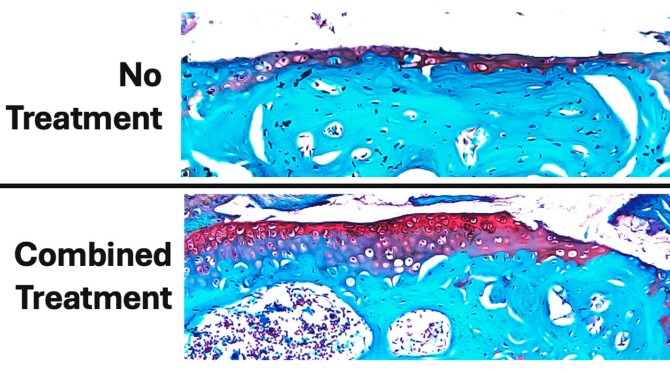Applying a pretreatment of a parathyroid hormone, commonly used to increase bone mass to combat osteoporosis, can help improve cartilage health and slow the development of osteoarthritis, Cornell researchers have found.
The team, led by Marjolein van der Meulen, the James M. and Marsha McCormick Director of the Meinig School of Biomedical Engineering in Cornell Engineering, also identified gene expression signatures that could potentially be used to detect the early onset of the degenerative joint disease.
This figure shows the extent of cartilage damage after 6 weeks of daily loading and treatment compared to a non-loaded control knee with no cartilage damage present. The cartilage is stained red, and the bone is stained bluish green. Overall, combined parathyroid hormone pretreatment prior to loading and alendronate treatment during loading had the least cartilage damage (loss of red-stained tissue) and preserved the most cartilage.
The findings were published April 19 in Science Advances. The co-lead authors are Adrien Antoinette, Ph.D. '23 and Sophia Ziemian, Ph.D. '20.
Van der Meulen specializes in exploring the role of mechanics in the skeleton and how the musculoskeletal system - bones, cartilage, joints - responds to loading, using a technique to apply weight and compress the lower leg and knee joint.
Loading is something of a mixed blessing. Because it increases bone mass, it can be used as a therapy for osteoporosis. At the same time, loading also damages the cartilage in joints, similar to the degeneration seen in osteoarthritis. Van der Meulen and her lab members have been increasingly focused on the role that bone plays in the development of this type of joint damage.
For the new study, her team conducted a two-step process. First, they pretreated mice daily with parathyroid hormone - a treatment prescribed for osteoporosis - to increase the animal's bone mass over a period of eight weeks. In the second phase, the team applied daily loading on the mouse's tibia and used another osteoporosis treatment, alendronate, that in effect turned off the bone's ability to renew itself - a process called remodeling - for six weeks.
"Bone is a tissue that constantly turns over. Cells continually remove bone and replace it with new bone. As you get older, this process is less efficient, and less bone gets put back," Van der Meulen said. "The way some FDA-approved osteoporosis drugs work is by shutting down this natural turnover process, so you're not losing bone mass. So we asked, if we block the ability of bone to respond, will that affect the development of the damage in the knee joint?"
The researchers found the parathyroid hormone directly improved cartilage health and slowed the development of damage, while the alendronate reduced the subchondral bone changes that are associated with osteoarthritis.
"Even after six weeks of damage, that eight-week pretreatment effect was still a very large effect. Parathyroid hormone did more than increase bone mass because, it turns out, this agent also acts on cartilage," said Van der Meulen. "The mouse knees had thicker cartilage after eight weeks, which wasn't something we expected. And so likely thicker cartilage protects you against joint damage downstream."
The team repeated the experiment and used transcriptomics to reveal the gene expression that occurred in RNA isolated from the mouse's cartilage, bone and lymph nodes. The joint damage was reflected in early transcriptomic changes, and both treatments combined resulted in early modulation in the immune signaling.
"What was really interesting is the gene expression data suggested that the two drugs paired together had the biggest effect in attenuating cartilage damage genes, and particularly altering expression of immune genes," Ziemian said.
This result suggests subtle changes occur due to the loading and treatments that can't be detected at the tissue level.
"The gene expression analysis is super useful for us in terms of seeing all these immune genes expressed in cartilage, which was not necessarily something we were expecting to see," Ziemian said. "Cartilage is a tissue that doesn't have a lot, if any, immune cells present in it normally."
The next step is to determine if the parathyroid hormone treatment can slow or even reverse the progression of osteoarthritis once it's already present, and to see if the gene signatures can be used in developing an early diagnostic for the disease.
"The findings imply that these treatments may be beneficial for humans as well. And the nice thing is, these treatments are FDA-approved already, they're just not approved for this application," Van der Meulen said.
Co-authors include Allison Brown '20, Erin Hudson '22 and Carolyn Chlebek, Ph.D. '22; Timothy Wright, Steven Goldring and Mary Goldring of Hospital for Special Surgery; and Miguel Otero, assistant professor of cell and developmental biology in orthopaedic surgery at Weill Cornell Medicine and Hospital for Special Surgery.
The research was supported by the U.S. Department of Defense, the National Institutes of Health and The Clark Foundation.







